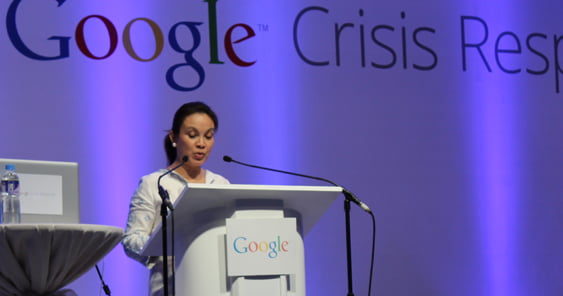MANILA – Even with the growing number of digital tools in crisis response, the bayanihan spirit that Filipinos are known for is still very much a key in dealing with disasters.
Keynote speaker Sen. Loren Legarda called for a cooperation between private and public to better cope with disasters as they come. “We should all be as vigilant in preparing for calamities as we are in responding to crises,” Legarda said at the Google Crisis Response Summit, held at the SMX Convention Center on April 30.
The summit is part of Google’s push for more innovation for disaster-control technology to cope with what is rapidly being considered as “the new normal”; a world with disaster-level incidents happening constantly.
Legarda spoke about a few of the laws and regulations in place in the country regarding crisis response. She also called on the Google development teams in the country to collaborate with her on making a “risk finder” application, which to her would help volunteers and responders in case of an emergency. Legarda willingly extended help from her office to make this happen.
“Unfortunately, the Philippines is prone to natural disasters. But the way that volunteers and local authorities have come together to share information around recent disasters has been inspiring,” said Meryl Stone, Google’s representative for its Crisis Response team.
Stone cited the efforts of the Filipino Google team during the Yolanda disaster, who painstakingly mapped out the affected areas and included the locations of every relief center in the area, which helped thousands of people.
Google also discussed two of its crisis response technologies: the Google Person Finder, a hub of information wherein people may be found during a crisis. With the amount of person-finder websites growing exponentially with every disaster, there was a need to consolidate this information to make it more accessible. Google’s Person Finder aims to do just that, using the same concept behind their search engine: collect data from other sites and collate it into one uniform site.
Google also spoke of its Crisis Maps, a variant of their popular Google Maps program that is adjusted to help first responders, volunteers and the public at large to know of critical emergency data in the event of a disaster. It puts disaster-related geographic data in the program, such as relief centers, sources of fresh water and the like and sends it to people who need it the most.
Still under development is the Google Public Alerts app, which is integrated within the Android OS, and will, in case of emergency, inform users of evacuation notices and locations in case of disaster.
During the summit, Google demonstrated its crisis response technologies, where participants were given hands-on lessons on how to use the programs to help in times of crisis. The programs were, according to one participant who used it for the first time, a bit “top-heavy at first, but is simple enough to be understandable.”
The talks ended with a panel discussion peopled by representatives from various government, NGO and private bodies, including the Philippine Red Cross, Department of Social Welfare and Development, National Disaster Risk Reduction and Management Council, Globe Telecom and various others, where they exchanged ideas among themselves and the audience on the management of any kind of crises.








